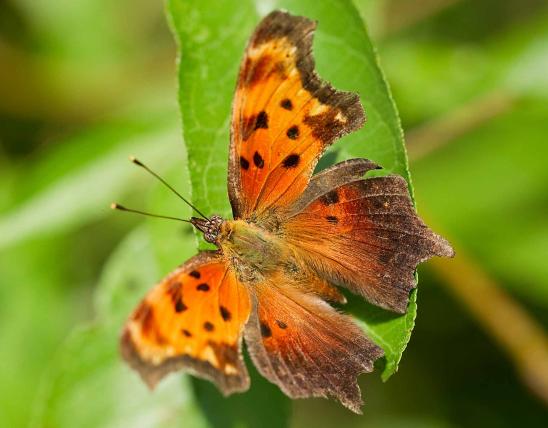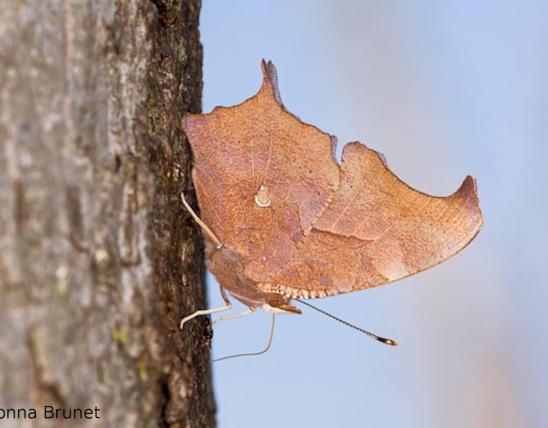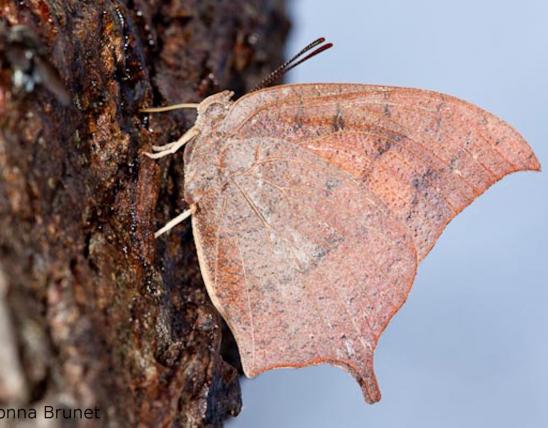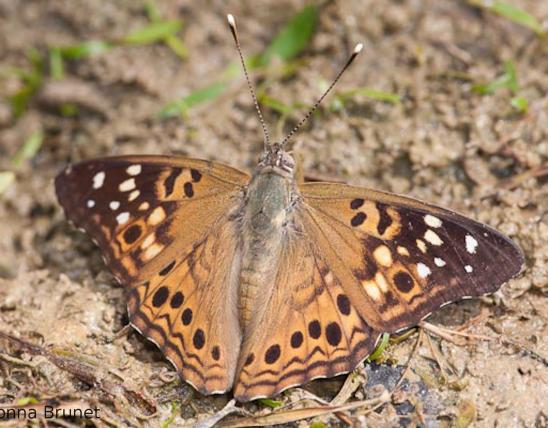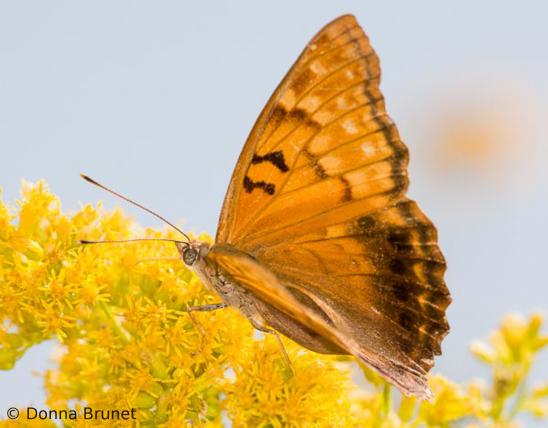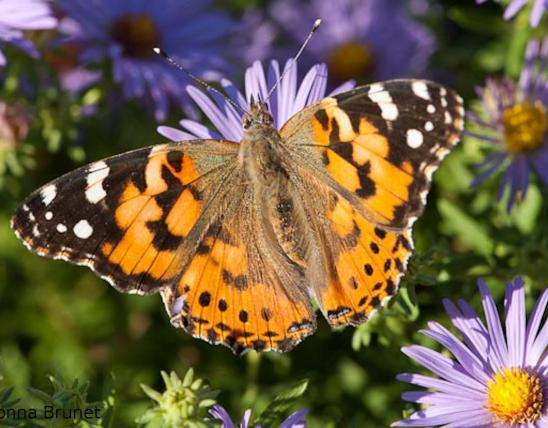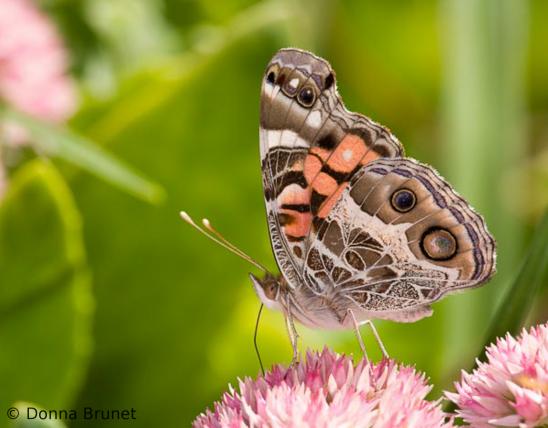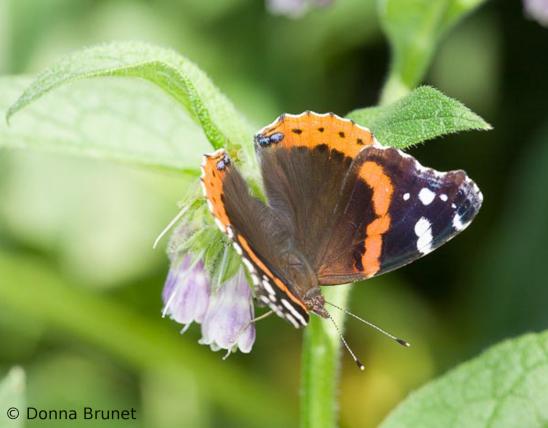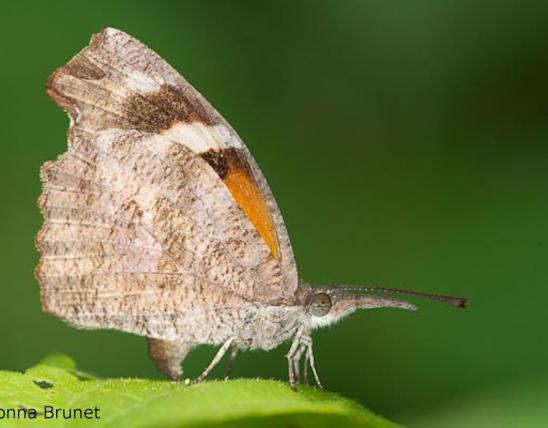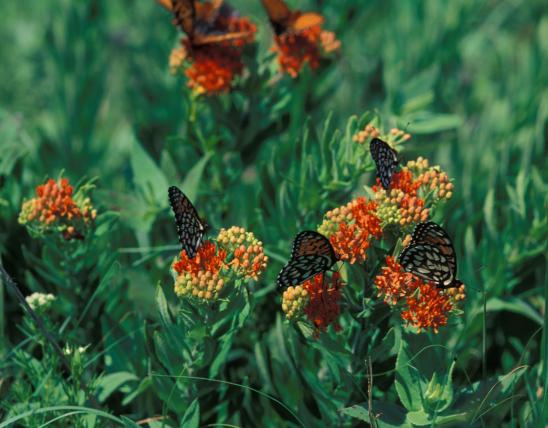
The gray comma is easy to ID if you can see the underside: it is charcoal gray with many fine dark streaks, and its comma marking is L-shaped and narrows to a fine point at each end.
Adult: Like its close relatives, the eastern comma (P. comma) and question mark (P. interrogationis), the gray comma has an orange and black dorsal (top) side of the wings. The two “commas,” however, lack the question mark’s hyphen-like line over the three black forewing spots. The dorsal hindwing of the gray comma lacks the central dark smudge that is present on the eastern comma. Viewed from above, the dark border of gray commas varies by season: in summer, the border is quite wide, but the winter form has it narrower, covering only about a fourth of the wing. The border is lined with a few small yellow spots. Beneath, the color is charcoal gray and finely streaked with dark lines. The small white “comma” mark on the hindwing is L-shaped and narrows to a fine point at each end. The forewing has a dark outer edge with some black chevrons in it.
Caterpillars are yellowish brown with dark markings. The spines are blackish.
Similar species: If you can see the underside hindwing, question marks have a dot next to the curved white marking, and eastern commas have blunt ends on the white comma. But here are extra clues: the eastern comma can be slightly larger, and its wings are less noticeably streaked.
Wingspan: 1½–2 inches.
Statewide.
Habitat and Conservation
The gray comma is more local in occurrence than either the eastern comma or the question mark. It is typically found in woodland areas, especially along creeks and on brushy slopes. Adults fly spring through fall, and overwintering adults may emerge from their resting places and fly around on warm winter days.
Food
Caterpillars eat native gooseberry species and are also reported on azaleas. They feed on the undersides of leaves. Adults may occasionally visit flowers, but they prefer tree sap and decaying fruit.
Status
Breeding resident found in local colonies across the state.
Life Cycle
Winter-form adults overwinter in hibernation and emerge in springtime. These mate and lay eggs, which hatch into caterpillars and become the summer-form adults. These butterflies fly in June through August. Their eggs then hatch, grow as caterpillars, pupate, and emerge at new winter-form adults in October. These individuals will hibernate. Eggs are laid singly on host plant leaves. Males perch on shrubs near clearings and wait for females to fly near.
Human Connections
If you love butterflies, there are many ways to increase your enjoyment. Butterfly gardening, watching, and photography are rewarding avocations. You can also rear the caterpillars, join butterfly organizations, or participate in “citizen science” programs. Many of these activities contribute to butterfly conservation, so they are things that you can feel good about.
Congratulations if you can tell the difference between a gray comma and eastern comma! This shows you’ve definitely progressed beyond a “beginner” level in butterfly identification. As the artist Georgia O’Keeffe said about flowers, “Nobody sees a flower — really — it is so small it takes time — we haven’t time — and to see takes time, like to have a friend takes time.”
Ecosystem Connections
Butterflies, in their different life stages, have many ways of avoiding predators. As adults, the gray comma typically rests with wings closed, with only the camouflaged gray undersides showing. When they perch on tree bark, they are virtually invisible.
When not actively feeding , the caterpillars rest on the undersides of leaves or on leaf stems. Holding on with only the middle pairs of prolegs, they bend the front half of their body to the side and lift the rear end into the air. If a predator or other enemy approaches, they wave both ends of their bodies from side to side. Apparently this serves to deter predators.
This species is in a butterfly family called the brush-footed butterflies. Members of this family have the first pair of legs small, brushlike, and held against the body, so they perch and walk only with their back two pairs of legs, making them appear four-legged.
























